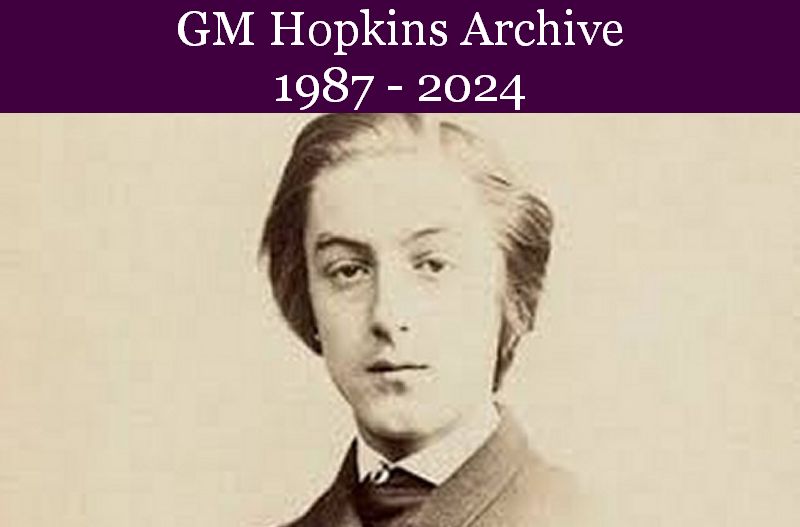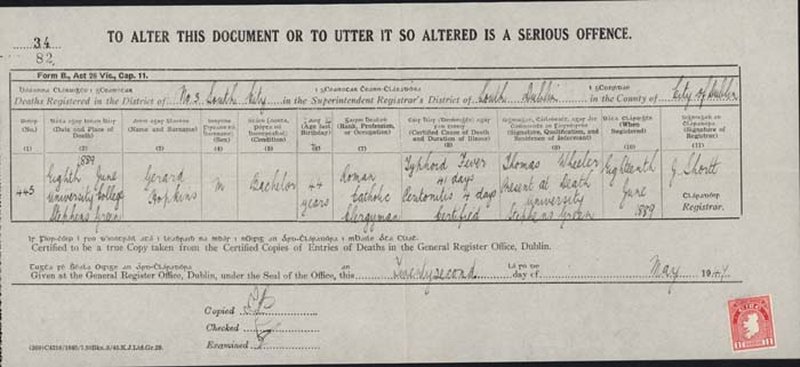Clinical Psychology, Hopkins and Poetry
Aidan Clegg
University of Southampton,
This Lecture was delivered at the Hopkins Literar Festival 2012
UK
Everyone agrees that Hopkins was not a carefree soul. More than most,
he fretted and brooded. Off and on, he fell prey to melancholy and
anomie. Sometimes—as during his years in Dublin—matters came to a head.
Happily for us, Hopkins extracted immortal diamonds from this emotional
ore—his so-called “terrible sonnets”. Unhappily for Hopkins, he had to
do all the mining.
Enter the . Hopkins, he avers, was suffering
from depression. This, science tells us, is a well-defined
mental disorder. It is characterized by the persistence of some
critical combination of following symptoms: gloom, guilt, shame, and
self-hatred; indecisiveness, irritability, pessimism, and rumination;
fatigue, apathy, insomnia, and ahedonia; difficulty concentrating,
psychomotor retardation, intermittentlachrymation, suicidal
ideation; and—“no worse, there is no none”—low sex drive.
As regards
its causes, depression is product of inborn vulnerabilities, mediated
by multiple genes, interacting with environmental stressors, like
failure and loss. Some progress has been made towards identifying its
biological basis. It’s no longer—as the Roman physician Galen believed—an excess of black bile, releasing noxious vapours. Instead,
it’s serotonin-releasing neurons, too lazy to fire properly.
Accordingly, standard therapy now consists, not only of trying to cheer
people up, but also of giving their idle neurons a chemical prod.
Equipped with such profound modern insights, it would surely be remiss not to interpret the life and work of Hopkins in light of these insights.
For example, when Hopkins awakens “to feel the fell of dark, not
day”, have his sleep patterns not been disrupted, and his circadian
rhythms unsprung? When he complains, “Why must disappointment all I
endeavour end”, is he not being just a tad negativistic? And when he
fixates on gastric sensations—“I am gall. I am heartburn”—has not
lapsed into unhealthy self-absorption?
In Hopkins’s biography, moreover, key triggers of depression are
apparent. These include insecure attachment, a lack of
social support, and learned helplessness. Did Hopkins
not sometimes long to make a deeper connection with others, lamenting
“dead letters sent to dearest him that
lives—alas!—away”? Did he not fail to integrate socially with his
Jesuit peers, leading a lonely life “at a third remove”? And, burdened
by his heavy teaching duties, was he not frustrated by his perceived
failure to even “breed one work that wakes”?
So theory and research on depression can enrich interpretations of
Hopkins’s life and work—and perhaps in ways more telling than those I
have just described. In particular, they can enable scholars to make
plausible and informed connections that they might otherwise miss.
Nonetheless, when one applies clinical psychology in this way, it’s
important to appreciate its pitfalls too.
Consider the controversy over what exactly ailed Hopkins. Was it major
depression, a clinical condition? Or was it something milder, like
dysthymia? There are actually two issues to decide here, one
substantial, the other definitional.
The substantial issue pertains to the actual severity of the
depressive symptoms that Hopkins experienced. Some commentators, like
biographers Norman White and Robert Martin, interpret Hopkins’s
depression as engulfing and disabling. Others, like Desmond Egan and
myself, interpret it as troublesome but manageable. It’s a valid
debate.
The difficulty in resolving it arises in part because the
sample of historical evidence open to commentators is necessarily scant
and potentially unrepresentative. This creates ambiguity, and the more
ambiguity there is, the greater the potential for reading meanings into
Hopkins’s life and work rather than reading meanings out of it.
In this regard, the history of clinical psychology furnishes a salutary
lesson. Freudian psychoanalysis—that sprawling body of thought and
therapy—was once all the rage. Childhood was destiny, repression caused
neurosis, and sex explained everything. The relevant “evidence”
consisted solely of symbolic interpretations made by self-styled
experts. We now know — thanks to subsequent scientific research and
critical historical investigation—that Freudian psychoanalysis is 99%
hogwash. All those symbolic interpretations—authoritatively made and
respectfully believed—were delusional. Be warned: if it can happen to
thousands of s, it can happen to Hopkins scholars
too.
Let us now turn to the definitional issue. This pertains to identifying
the boundary between major depression and dysthymia. Crucially, this
boundary is not discovered: rather it is declared. To
understand this, consider first how two physical ailments of differing
severity—colds and ’flus—are distinguished. Colds are not ‘flus: you
either have one, or you have the other. The symptoms differ, but a
doctor can also check for biological signs—such as viral
antibodies—that definitively tell the two ailments apart. But when it
comes to distinguishing major depression from dysthymia, there are no underlying signs: they are only apparent symptoms.
Moreover,
the severity of depressive symptoms varies continuously from person to
person, meaning there are no natural gaps, including none between major
depression and dysthymia. Hence, any boundary between them must have
been put there: it’s not out there in the world to begin
with. Accordingly, the question of what ailed Hopkins—major depression
or dysthymia—is as much a matter of definition as it is of diagnosis.
But surely, you say, s, with their years of
practical experience, must know best where to draw boundaries. Well,
less than you might expect. For example, studies show that, even when
diagnosing major disorders using identical checklists, “experts”
disagree surprisingly often. Indeed, diagnoses of depression are among
the most divisive. So ask yourself this: if “experts”
disagree, and there is no physical court of appeal, can a clinical
diagnosis ever really be right or wrong? Isn’t it just a case
of majority rule?
Clinical psychologists sometimes retort that their diagnostic
difficulties stem from the complication of co-morbidity—that
is, people presenting with more than one disorder at the same time. But
this is an evasive gambit. The truth is that mental disorders are inherently
fuzzy: they do not merely overlap. People mix and match symptoms
in ways that confound neat characterization. True, there is usually a
basic theme to people’s symptoms; but each person adds their own set of
variations. Because of all this inherent fuzziness, there is always
more than one defensible way of classifying clusters of symptoms.
Hence, the question of even whether Hopkins had depression,
and not something else, is partly a matter of definition too.
It gets worse: value judgments contaminate clinical judgments. For
example, is homosexuality a disorder? Well, not since 1974 apparently,
when a panel of “experts” removed it from that bible of mental
pathology, the Diagnostic and Statistical Manual of Mental Disorders.
And just last year, narcissism—a well-established personality
disorder—nearly shared the same fate. Only a last-minute backlash from
s kept it in—perhaps they feared losing business.
So, is depression bad enough to be a definitely dubbed a disorder?
Well, the answer is not clear-cut. No lesser an authority than
Aristotle considered depression to be the source of artistic genius.
And Robert Burton—whose book The Anatomy of Melancholy was
Renaissance best-seller—regarded depression as a sweet meditative mood
that had an unfortunate tendency to get out of hand. But let’s return
to Hopkins during his Dublin years. Was he down in the dumps, and a
candidate for Prozac? Or was his going through a Dark Night of the
Soul, and a candidate for sanctity? I don’t know the answer. But I
suspect s—lacking expertise in moral
theology—don’t know it either. One thing’s for sure: in figuring out
exactly what ailed Hopkins, we may have to stray beyond the realm of
positive science.
I have dwelt on Hopkins’s depression a lot—and unduly so. Which brings
me to my final point: depression was but one facet of Hopkins’s life
and work, to be understood in the context of many other facets.
Aristotle was partly right that artists are depressive—studies confirm
a statistical correlation—but we must be careful not to caricature
them. So suppose we wished to give a rounded and unbiased psychological
portrait of Hopkins. How might we go about it?
Well, one way would be to characterize him in terms of several basic
personality traits. But how can we identify these? As follows: if
they are basic, they should matter in everyday life; and if they matter
in everyday life, they should enter public discourse. Accordingly, the
statistical analysis of adjectives habitually used to describe
people should reveal those basic traits. And reveal them it does:
the same handful of traits reliably emerges across different languages
and cultures.
In terms of two of these, Hopkins’s indeed fits the
stereotype of the brooding artist: he was, relative to the average
person, somewhat lower in extraversion (i.e., he was less
talkative, assertive, and gregarious) and also somewhat lower in emotional
stability (i.e., he was less buoyant, placid, and equable). But
four traits still remain. In my estimation, Hopkins was also higher in openness
to experience (i.e., he was more curious, creative, and
imaginative), higher in conscientiousness (i.e., he was more
self-disciplined, dutiful, and organized), higher in agreeableness (i.e., he was more friendly, considerate, and sympathetic), and higher
in honesty-humility (i.e., he was more sincere, faithful, and
unassuming), relative to the average person. This latter quartet of
traits should not be neglected in interpreting his life and work: they
are arguably just as relevant as the former pair.
As for his “terrible sonnets”, Hopkins’s depression hardly suffices to
explain them. Depressive illness is frequent—the “common cold” of
mental disorder—whereas superlative poetry is rare. Depression
therefore explains Hopkins’s “terrible sonnets” only in so far as
gravity explains plane crashes. It’s a necessary condition for their
occurrence, but hardly a sufficient one, and definitely not the one of
greatest interest. Consider: even Hopkins’s bare commitment to
documenting his depression in exacting sonnet form testifies to his
attempts to resist it. Moreover, each sonnet recounts a dogged search
for meaning as much as it expresses a heartfelt cri de coeur.
The tone recalls the counterpoint of Bach as much as the melodrama of
Tchaikovsky. For me, the keynote of Hopkins’s “terrible sonnets” is
resolute will, animated by faith, not wayward emotion, born of
dysfunction. In terms of basic personality traits, I would say that
Hopkins’s exceptional conscientiousness and honesty-humility shine
through more than his impaired emotional stability.
In conclusion: when trying to understand Hopkins’s life and work,
listen to what s have to say. But take care to
recognize the pitfalls of diagnosing mental disorders, and to
appreciate the validity of wider perspectives.
Links to other 2012 Hopkins Festival Lectures

